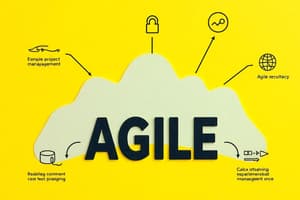Podcast
Questions and Answers
The Agile Manifesto was published in ______ as a better way of delivering software and systems projects.
The Agile Manifesto was published in ______ as a better way of delivering software and systems projects.
2001
Agile is not a methodology but a mindset or way of ______.
Agile is not a methodology but a mindset or way of ______.
thinking
The most efficient method of conveying information in a development team is ______ conversation.
The most efficient method of conveying information in a development team is ______ conversation.
face-to-face
Agile focuses on increasing value to customers and minimizing ______.
Agile focuses on increasing value to customers and minimizing ______.
Agile principles can be derived from the ______ values found in the Agile Manifesto.
Agile principles can be derived from the ______ values found in the Agile Manifesto.
The principles of Agile aim to support continuous delivery and __________.
The principles of Agile aim to support continuous delivery and __________.
Students will explore how to respond to change the __________ way.
Students will explore how to respond to change the __________ way.
The course will cover values and principles from the Agile __________.
The course will cover values and principles from the Agile __________.
One focus of the course is enhancing communication with user __________.
One focus of the course is enhancing communication with user __________.
Agile emphasizes collaboration in __________ teams.
Agile emphasizes collaboration in __________ teams.
The course will introduce popular Agile __________.
The course will introduce popular Agile __________.
During the course, students will discuss traditional project management and its key __________ from Agile.
During the course, students will discuss traditional project management and its key __________ from Agile.
The class structure includes lectures, __________, and practice exercises.
The class structure includes lectures, __________, and practice exercises.
Our highest priority is to satisfy the customer through early and ______ delivery of valuable software.
Our highest priority is to satisfy the customer through early and ______ delivery of valuable software.
Agile processes welcome changing requirements, even ______ in development.
Agile processes welcome changing requirements, even ______ in development.
Deliver working software frequently, from a couple of weeks to a couple of ______.
Deliver working software frequently, from a couple of weeks to a couple of ______.
Business people and developers must work together ______ throughout the project.
Business people and developers must work together ______ throughout the project.
The most efficient and effective method of conveying information to and within a development team is ______ conversation.
The most efficient and effective method of conveying information to and within a development team is ______ conversation.
Build projects around motivated individuals. Give them the environment and support they need, and ______ them to get the job done.
Build projects around motivated individuals. Give them the environment and support they need, and ______ them to get the job done.
Continuous attention to technical excellence and good design enhances ______.
Continuous attention to technical excellence and good design enhances ______.
Simplicity–the art of maximizing the amount of work not done–is ______.
Simplicity–the art of maximizing the amount of work not done–is ______.
Our highest priority is to satisfy the customer through early and continuous delivery of valuable ______.
Our highest priority is to satisfy the customer through early and continuous delivery of valuable ______.
Agile processes welcome changing ______, even late in development.
Agile processes welcome changing ______, even late in development.
Deliver working software frequently, with a preference to the shorter ______.
Deliver working software frequently, with a preference to the shorter ______.
Business people and developers must work together daily throughout the ______.
Business people and developers must work together daily throughout the ______.
Micromanagement doesn’t work. Build and empower the ______ to deliver the project.
Micromanagement doesn’t work. Build and empower the ______ to deliver the project.
The most efficient method of conveying information to a development team is face-to-face ______.
The most efficient method of conveying information to a development team is face-to-face ______.
Working software is the primary measure of ______.
Working software is the primary measure of ______.
Simplicity is essential–the art of maximizing the amount of work not ______.
Simplicity is essential–the art of maximizing the amount of work not ______.
The Agile Manifesto values individuals and interactions over ________ and tools.
The Agile Manifesto values individuals and interactions over ________ and tools.
The Agile approach favors ________ software over comprehensive documentation.
The Agile approach favors ________ software over comprehensive documentation.
Agile promotes customer ________ over contract negotiation.
Agile promotes customer ________ over contract negotiation.
Agile values responding to change over following a ________.
Agile values responding to change over following a ________.
In Agile project management, ________ and refined backlog are essential for tracking tasks.
In Agile project management, ________ and refined backlog are essential for tracking tasks.
Agile includes techniques like ________ driven development to enhance software quality.
Agile includes techniques like ________ driven development to enhance software quality.
A ________ Chart is used to visualize the amount of work completed versus what remains.
A ________ Chart is used to visualize the amount of work completed versus what remains.
Agile methodologies emerged as a response to the limitations of traditional ______ management.
Agile methodologies emerged as a response to the limitations of traditional ______ management.
The concept of ________ programming involves two programmers working together at one workstation.
The concept of ________ programming involves two programmers working together at one workstation.
The Agile Manifesto was introduced during the formation of the Agile ______ in 2001.
The Agile Manifesto was introduced during the formation of the Agile ______ in 2001.
One of the Agile Manifesto's values emphasizes valuing ______ over processes and tools.
One of the Agile Manifesto's values emphasizes valuing ______ over processes and tools.
Rapid Application Development was developed by ______ in the 1980s.
Rapid Application Development was developed by ______ in the 1980s.
Extreme Programming, also known as XP, was created by ______ in 1996.
Extreme Programming, also known as XP, was created by ______ in 1996.
The ______ framework, created by Jeff Sutherland in 1993, is a widely used agile methodology.
The ______ framework, created by Jeff Sutherland in 1993, is a widely used agile methodology.
The principle of delivering working software frequently helps to reduce ______ in projects.
The principle of delivering working software frequently helps to reduce ______ in projects.
Having an agile ______ means being flexible and open to change throughout the project.
Having an agile ______ means being flexible and open to change throughout the project.
Flashcards
Waterfall Model
Waterfall Model
A traditional project management method that follows a linear, sequential approach. It emphasizes planning and documentation, with a clear division of phases.
Agile Methodology
Agile Methodology
A software development method that emphasizes flexibility and adaptability. It encourages iterative development, collaboration, and continuous feedback.
Agile Manifesto
Agile Manifesto
A collection of principles and values that promote collaboration, customer satisfaction, and continuous improvement.
Agile Principles
Agile Principles
Signup and view all the flashcards
Iterative Development
Iterative Development
Signup and view all the flashcards
Flexibility in Agile
Flexibility in Agile
Signup and view all the flashcards
Customer Satisfaction in Agile
Customer Satisfaction in Agile
Signup and view all the flashcards
Continuous Improvement in Agile
Continuous Improvement in Agile
Signup and view all the flashcards
Agile
Agile
Signup and view all the flashcards
Traditional Project Management (Waterfall)
Traditional Project Management (Waterfall)
Signup and view all the flashcards
User Stories
User Stories
Signup and view all the flashcards
Cross-Functional Teams
Cross-Functional Teams
Signup and view all the flashcards
Responding to Change
Responding to Change
Signup and view all the flashcards
Agile Frameworks
Agile Frameworks
Signup and view all the flashcards
Agile Team Roles
Agile Team Roles
Signup and view all the flashcards
Agile Development
Agile Development
Signup and view all the flashcards
Lean
Lean
Signup and view all the flashcards
Individuals and Interactions
Individuals and Interactions
Signup and view all the flashcards
Working Software over Documentation
Working Software over Documentation
Signup and view all the flashcards
Customer Collaboration over Contract Negotiation
Customer Collaboration over Contract Negotiation
Signup and view all the flashcards
Responding to Change over Following a Plan
Responding to Change over Following a Plan
Signup and view all the flashcards
Backlog
Backlog
Signup and view all the flashcards
Backlog Refinement
Backlog Refinement
Signup and view all the flashcards
Burndown Chart
Burndown Chart
Signup and view all the flashcards
Customer Satisfaction
Customer Satisfaction
Signup and view all the flashcards
Embrace Change
Embrace Change
Signup and view all the flashcards
Frequent Delivery
Frequent Delivery
Signup and view all the flashcards
Collaboration
Collaboration
Signup and view all the flashcards
Empowerment
Empowerment
Signup and view all the flashcards
Face-to-Face Communication
Face-to-Face Communication
Signup and view all the flashcards
Working Software
Working Software
Signup and view all the flashcards
Sustainable Development
Sustainable Development
Signup and view all the flashcards
Feedback from Users
Feedback from Users
Signup and view all the flashcards
Delivering Working Software Frequently
Delivering Working Software Frequently
Signup and view all the flashcards
Collaboration between Business People and Developers
Collaboration between Business People and Developers
Signup and view all the flashcards
Building Projects Around Motivated Individuals
Building Projects Around Motivated Individuals
Signup and view all the flashcards
Self-Organizing Teams
Self-Organizing Teams
Signup and view all the flashcards
Study Notes
Course Information
- Course name: MGMT8085: Agile Principles
- Course week: 1
- Class: 1
- Introduction to Agile
Course Overview
- The course dives into Agile principles for continuous delivery and improvement in IT projects.
- Students will learn agile values and principles from the agile manifesto.
- The course will explore communication with user stories and cross-functional teams.
- It will teach how to adapt to change in an agile way, introduce popular agile frameworks, and common roles in agile teams.
Icebreaker with Class
- The class will have an icebreaker activity
- Students need to provide their:
- Name
- Academic Background
- Reasons for choosing Conestoga, the program, or things they want to learn that semester.
Course Format & Evaluations
- The course schedule includes quizzes (1, 2, 3, 4), an assignment (1), midterm exam, and a group project (2 parts).
- The course has a student success week 8.
- There will be a final exam.
Resources
- eConestoga
- Weekly content
- PowerPoint Slides
- E-Text Resource
- Agile Practice Guide (190 pages) - published by Project Management Institute in September 2017
Introduction to Agile
- The course introduces Agile principles.
- The class format includes:
- Lecture (35 minutes)
- Break (10 minutes)
- Lecture & Exercise (50 minutes)
- Break (10 minutes)
- Practice Exercise/Discussion (25 minutes)
- Asynchronous Hour (5 minutes)
- Summary (10 minutes)
- Q&A (5 minutes)
What is Agile?
- Agile focuses on:
- Thinking
- Interacting
Learning Objectives
- This section covers the course objectives.
- It includes:
- History of Agile
- Traditional vs. Agile Project Management
- Different Agile Methodologies
- The Agile Manifesto's 4 values and 12 principles
- Agile principles relation to the Software Development Life Cycle
- Customer value
- Project risk
- Agile mindset
Week 1: Agile Words
- This section is about agile words and introduces a website called Menti.com.
- Students need to enter a specific code or use QR code.
History of Agile
- Background information about Agile history
- Information about traditional project management
- Information about Agile methodologies
A Brief History of Agile
- Traditional Project Management (Waterfall)
- Agile Methodologies
- Formation of the Agile Alliance
- Agile Manifesto
- Agile Terms and Concepts
Traditional Project Management
- Waterfall and its suitability for defined work.
- Problems in Projects with high uncertainty
Agile Methodologies
- List of Agile Methodologies
- Example of each methodology with its developers.
Agile Alliance
- Formed in 2001
- Based on the Snowbird meeting
- Software Developers created 4 values and published the Agile Manifesto.
- Information about connection to Lean and Toyota Production system.
The Agile Manifesto
- Better ways of developing software by doing it and helping others to do it
- The manifesto includes these points:
- Individuals & interactions > processes & tools
- Working software > comprehensive documentation
- Customer collaboration > contract negotiation
- Responding to change > following a plan
Agile Terms & Concepts
- Includes a list of Agile terms.
Agile Explained
- What is the Agile mindset?
Agile Values
- Introduction to Agile Values
Value #1
- "Individuals and interactions over processes and tools'
- Explanation of the value in the context of project team members.
- Importance of communication and understanding.
Value #2
- "Customer collaboration over contract negotiation"
- Emphasize cooperation between clients and teams
- Emphasize the flexibility required in uncertain environments.
Value #3
- "Working software over comprehensive documentation"
- Documentation should be created when necessary, not everything.
- Feedback should be obtained promptly.
Value #4
- "Responding to change over following a plan"
- Iterative development process
- Importance of feedback from users
- Value of planning, but avoiding replanning
10 Min Exercise
- Activity for understanding the values.
Exercise Instructions
- Provide questions for small groups (4-5).
- Instructions for a value based discussion related to a practice
10 Minute Break
- Short break.
Agile Principles
- Explanations of the 12 principles of Agile
Principle #1
- Customer satisfaction through early and continuous delivery of valuable software.
- Waiting to deliver software at the end can cause customer dissatisfaction issues
Principle #2
- Welcome changing requirements.
- Agile processes enhance customer advantage.
- Small batch sizes and iterative development can help satisfaction.
Principle #3
- Deliver working software frequently.
- Preference to shorter timelines.
- Smaller batches reduce potential waste and rework.
Principle #4
- Business people and developers must work together daily.
- Collaboration and diversity yields better results with user feedback.
Principle #5
- Build projects around motivated individuals.
- Trust team members to complete tasks
- Micromanagement is counterproductive.
Principle #6
- The most efficient method of communication is face-to-face.
Principle #7
- Working software is the primary measure of progress
Principle #8
- Agile processes promote sustainable development.
- Maintains consistent pace of work for sponsors, developers, and users.
Principle #9
- Continuous attention to technical excellence and good design enhances agility
- Build quality to reduce waste and rework
- Self-forming teams achieve product ownership
Principle #10
- Simplicity-the art of maximizing the amount of work not done is essential.
- Value-added to each piece of work
Principle #11
- Best architectures, requirements, and designs emerge from self-organizing teams
- Combined skillsets support the development and delivery of products.
Principle #12
- Regular reflection and improvement by teams to increase efficiency
- Feedback for product and process to improve delivery.
Agile Mindset
- Section on Agile Mindset.
Implementing an Agile Mindset in PM
- Understanding different frameworks and their principles.
How it all connects
- Agile is defined by values and principles with practices manifesting.
10 Minute Break
- Time to Rest
In-Class Exercise
- Discussing 12 principles in groups of 4-5
- Discussion on one approach.
- Principles for program/course application.
- Principles for future career application.
Agile Principles (again)
- Another list of Agile principles.
Asynchronous Activity for Week 1
- Reviewing a video on introduction to agile.
Asynchronous Hour Instructions
- Questions to answer about the video:
- The agile framework James Newkirk is most familiar with.
- One thing James recommends for implementing agile frameworks.
Test Your Knowledge
- The section about testing knowledge.
Week 1: Test Your Understanding of Agile
- Use Menti.com or a QR code.
Summary
- Key takeaways are presented about agile
- Information about the importance of agile.
- Importance of agile methodology in modern business.
Key Take-Aways
- Agile Alliance published Agile Manifesto.
- Agile is a mindset, and not a methodology
- High uncertainty work required a new method.
- Agile Manifesto includes values and principles.
- Agile, like Lean, focuses on increasing value and minimizing waste.
- Minimizing risk to customers increases value and eliminates waste.
Next Class
- Discussion on the relationship of agile values, principles, and practices in project management.
- Information on Lean and Agile practices.
- Derived agile principles from the agile manifesto.
Studying That Suits You
Use AI to generate personalized quizzes and flashcards to suit your learning preferences.
Related Documents
Description
Test your understanding of Agile principles as introduced in Week 1 of the MGMT8085 course. This quiz will cover key values and frameworks, along with communication techniques essential for agile teams. Prepare to reinforce your knowledge of the Agile manifesto and its applications in IT projects.




